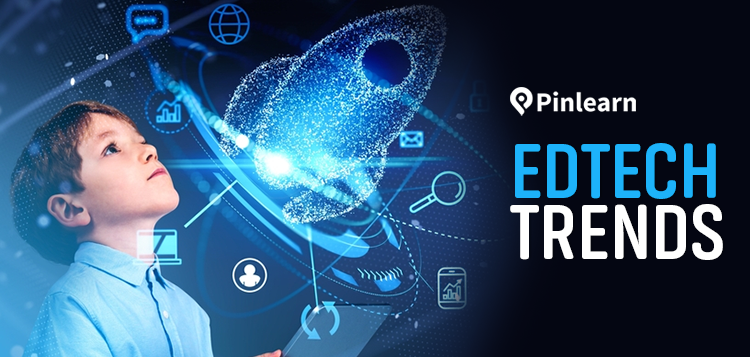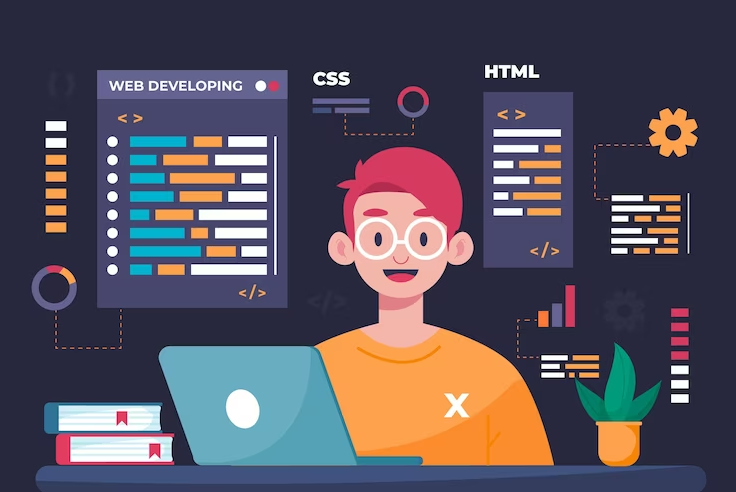Top EdTech Trends 2025
Posted On July 11, 2025

As we move deeper into the digital age, education technology (EdTech) continues to evolve at a rapid pace, fundamentally altering how learning is delivered, consumed, and measured. In 2025, India’s EdTech landscape is entering a new era marked by AI-driven personalization, immersive learning environments, hybrid classrooms, and an increasing focus on inclusivity and regional access. With over 500 million internet users below the age of 25, India is the largest EdTech market after the US and China. This article explores the top EdTech trends defining Indian education in 2025, reshaping the ecosystem across K-12, higher education, and skilling domains.
1. AI-Powered Personalized Learning
One of the most transformative EdTech trends of 2025 is the widespread adoption of AI-driven adaptive learning platforms. These systems dynamically adjust content difficulty, format, and sequence based on a student’s performance, preferences, and behavioral data. Platforms like Byju's AI+, Vedantu Intelligence, and Embibe Scholar now use advanced data analytics to generate real-time feedback, practice recommendations, and performance predictions. Government portals like DIKSHA 2.0 are integrating similar tools to ensure equitable access to personalized instruction for students in rural areas. AI is not just about content delivery-it’s changing student assessment. Formative AI testing engines now evaluate student responses with emotional intelligence markers, encouraging self-reflection and deeper conceptual understanding.
2. Immersive Learning- AR, VR & MR
Immersive technologies like Augmented Reality (AR), Virtual Reality (VR), and Mixed Reality (MR) have finally moved from the pilot phase to mainstream education. Schools and higher-ed institutions are increasingly adopting virtual labs, 3D models, and gamified simulations to make learning experiential. For instance, ClassVR India has partnered with over 2,000 schools to create subject-specific virtual field trips-students can now walk through the Indus Valley Civilization or explore photosynthesis inside a leaf. Engineering and medical colleges are using VR-based dissection and surgery simulators, replacing expensive equipment with digital precision. Platforms like Google Lens for Education are enabling students to overlay mathematical graphs, chemical structures, and biological processes in real-time via smartphone cameras.
3. Rise of Multilingual & Vernacular EdTech
A key focus for 2025 is bridging the language barrier in digital education. With over 60% of Indian students studying in non-English mediums, vernacular EdTech has grown rapidly. Startups like Kutuki (pre-school in regional languages) and Doubtnut (Hindi STEM solutions) are now being supplemented by government AI initiatives like Bhashini, which offer voice-based translation and text-to-speech features in over 22 languages. The National Education Policy (NEP) 2020’s emphasis on mother tongue learning has also fueled regional content creation. Teachers are now uploading lesson plans, assessments, and videos in Bengali, Tamil, Kannada, and even tribal dialects. The new frontier is multilingual AI tutors-chatbots that can aNSEer student queries in regional languages and switch seamlessly based on student preference.
4. Hybrid Classrooms and Blended Learning
COVID-19 pushed digital learning to the forefront, but 2025 has seen a return to physical classrooms-with a twist. Hybrid models that combine classroom teaching with digital tools have become the norm. Smartboards, projectors, AI-lesson planners, and cloud storage systems are now standard in urban schools. Meanwhile, in semi-urban and rural schools, low-bandwidth LMS (Learning Management Systems) and offline content sync devices are helping bridge the digital divide. Platforms like Teachmint Hybrid offer end-to-end solutions- attendance tracking, digital homework, interactive quizzes, and live parent-teacher meetings. Even university campuses are moving to flipped classrooms-students learn content online and spend in-class time on group projects, Q&A, or labs.
5. Skilling, Upskilling, and Micro-Credentials
The future of work is rapidly evolving, and EdTech platforms have pivoted to meet the demand for job-ready skills. Skilling platforms like Scaler, UpGrad, and Simplilearn are offering micro-credentials, nano degrees, and industry-certified programs in data science, AI/ML, fintech, climate tech, and more. Companies are now partnering directly with platforms to sponsor skill development, offering guaranteed internships or placement-linked bootcamps. Even the government has launched Skill India Digital, an integrated skilling portal with AI career advisors and multilingual career paths.
Importantly, more women, rural youth, and differently-abled learners are enrolling, as scholarships and free coding camps grow.
6. Education for Neurodiverse and Differently-Abled Learners
Inclusion is another defining trend in 2025. EdTech companies are integrating accessibility tools into platforms-
Voice-to-text and text-to-voice converters
Color-blind friendly interfaces
Sign language integrated tutorials
Emotion tracking for neurodiverse learners
Startups like Cogniable are designing AI solutions for children with autism and ADHD, offering customized therapy and learning strategies.
The government has updated its accessibility mandate, requiring EdTech platforms to meet WCAG 2.1 standards and support inclusive design.
7. Gamification and Learning Motivation
With attention spans shrinking, gamification is now a mainstream tool in Indian classrooms. Platforms like Kahoot, Quizizz, and ClassDojo have localized content, badges, and leaderboards to make learning competitive yet fun. Gamified platforms also include progressive leveling, AI rewards, and social sharing, which motivate students to engage more consistently. Teachers report that gamification helps reduce exam anxiety and fosters collaborative learning.
Startups like PlayAblo and LearnEngage offer curriculum-aligned gamified modules for state boards in both English and vernacular languages.
8. Blockchain in Academic Credentials
A lesser-discussed but growing trend is the use of blockchain technology in education. The government-backed NAD (National Academic Depository) now uses blockchain to store degrees, transcripts, and certificates, making them tamper-proof and easily verifiable. Universities like IIT Kanpur, Delhi University, and Anna University have adopted blockchain-based systems for issuing digital diplomas. Employers and institutions can verify credentials instantly without manual processing. This technology is also being explored for tracking student progress, recording micro-credentials, and enabling credit portability across platforms.
9. Teacher Enablement and AI-Coaching
2025 has seen EdTech shift focus toward teacher empowerment, not just student enrichment. Platforms like Suraasa, CENTA, and CTET Prep AI are helping teachers improve pedagogy, classroom engagement, and professional development. AI-based classroom observation tools analyze teacher delivery, interaction quality, and student response, giving personalized feedback. Teachers can also use AI lesson planners to create dynamic lesson flows in minutes. These platforms are particularly useful in Tier 2 and 3 cities, where access to in-service training is limited.
10. Regulation, Data Privacy, and EdTech Ethics
With rapid growth has come the need for regulation and ethical frameworks. The Ministry of Education is set to launch the India EdTech Code of Conduct 2025, which will regulate-
Student data privacy
Ad-free, child-safe content
Pricing transparency
Use of AI in assessments
The Personal Data Protection Bill, now tabled in Parliament, will impact how EdTech companies collect, store, and process student information. Platforms will need parental consent, encryption standards, and user control mechanisms. More importantly, a central EdTech rating authority will be established to accredit platforms based on accessibility, pedagogy, and impact.
Conclusion
The year 2025 marks a consolidation phase for India’s EdTech journey-moving from emergency adoption during the pandemic to a structured, inclusive, and innovative learning ecosystem. From AI tutors in local dialects to blockchain-verified degrees, from VR science labs in tribal schools to upskilling platforms for working adults-EdTech is truly democratizing education. Yet, its future lies in equity, ethics, and empowerment. Technology alone cannot solve deep-rooted issues in education, but when combined with human intent and policy support, it can build an education system that is personalized, inclusive, future-ready-and truly Indian at heart.
Teacher Tech Upskilling- Government schemes and private firms are investing in digital training for teachers, turning them into content creators and tech facilitators.
Data Analytics for Progress Monitoring- Real-time dashboards at state and school levels are helping monitor enrollment, attendance, and learning outcomes.
Gamification- Learning has become interactive with quizzes, leaderboards, and rewards driving engagement, especially in early education.
1. AI-Powered Personalized Learning
One of the most transformative EdTech trends of 2025 is the widespread adoption of AI-driven adaptive learning platforms. These systems dynamically adjust content difficulty, format, and sequence based on a student’s performance, preferences, and behavioral data. Platforms like Byju's AI+, Vedantu Intelligence, and Embibe Scholar now use advanced data analytics to generate real-time feedback, practice recommendations, and performance predictions. Government portals like DIKSHA 2.0 are integrating similar tools to ensure equitable access to personalized instruction for students in rural areas. AI is not just about content delivery-it’s changing student assessment. Formative AI testing engines now evaluate student responses with emotional intelligence markers, encouraging self-reflection and deeper conceptual understanding.
2. Immersive Learning- AR, VR & MR
Immersive technologies like Augmented Reality (AR), Virtual Reality (VR), and Mixed Reality (MR) have finally moved from the pilot phase to mainstream education. Schools and higher-ed institutions are increasingly adopting virtual labs, 3D models, and gamified simulations to make learning experiential. For instance, ClassVR India has partnered with over 2,000 schools to create subject-specific virtual field trips-students can now walk through the Indus Valley Civilization or explore photosynthesis inside a leaf. Engineering and medical colleges are using VR-based dissection and surgery simulators, replacing expensive equipment with digital precision. Platforms like Google Lens for Education are enabling students to overlay mathematical graphs, chemical structures, and biological processes in real-time via smartphone cameras.
3. Rise of Multilingual & Vernacular EdTech
A key focus for 2025 is bridging the language barrier in digital education. With over 60% of Indian students studying in non-English mediums, vernacular EdTech has grown rapidly. Startups like Kutuki (pre-school in regional languages) and Doubtnut (Hindi STEM solutions) are now being supplemented by government AI initiatives like Bhashini, which offer voice-based translation and text-to-speech features in over 22 languages. The National Education Policy (NEP) 2020’s emphasis on mother tongue learning has also fueled regional content creation. Teachers are now uploading lesson plans, assessments, and videos in Bengali, Tamil, Kannada, and even tribal dialects. The new frontier is multilingual AI tutors-chatbots that can aNSEer student queries in regional languages and switch seamlessly based on student preference.
4. Hybrid Classrooms and Blended Learning
COVID-19 pushed digital learning to the forefront, but 2025 has seen a return to physical classrooms-with a twist. Hybrid models that combine classroom teaching with digital tools have become the norm. Smartboards, projectors, AI-lesson planners, and cloud storage systems are now standard in urban schools. Meanwhile, in semi-urban and rural schools, low-bandwidth LMS (Learning Management Systems) and offline content sync devices are helping bridge the digital divide. Platforms like Teachmint Hybrid offer end-to-end solutions- attendance tracking, digital homework, interactive quizzes, and live parent-teacher meetings. Even university campuses are moving to flipped classrooms-students learn content online and spend in-class time on group projects, Q&A, or labs.
5. Skilling, Upskilling, and Micro-Credentials
The future of work is rapidly evolving, and EdTech platforms have pivoted to meet the demand for job-ready skills. Skilling platforms like Scaler, UpGrad, and Simplilearn are offering micro-credentials, nano degrees, and industry-certified programs in data science, AI/ML, fintech, climate tech, and more. Companies are now partnering directly with platforms to sponsor skill development, offering guaranteed internships or placement-linked bootcamps. Even the government has launched Skill India Digital, an integrated skilling portal with AI career advisors and multilingual career paths.
Importantly, more women, rural youth, and differently-abled learners are enrolling, as scholarships and free coding camps grow.
6. Education for Neurodiverse and Differently-Abled Learners
Inclusion is another defining trend in 2025. EdTech companies are integrating accessibility tools into platforms-
Voice-to-text and text-to-voice converters
Color-blind friendly interfaces
Sign language integrated tutorials
Emotion tracking for neurodiverse learners
Startups like Cogniable are designing AI solutions for children with autism and ADHD, offering customized therapy and learning strategies.
The government has updated its accessibility mandate, requiring EdTech platforms to meet WCAG 2.1 standards and support inclusive design.
7. Gamification and Learning Motivation
With attention spans shrinking, gamification is now a mainstream tool in Indian classrooms. Platforms like Kahoot, Quizizz, and ClassDojo have localized content, badges, and leaderboards to make learning competitive yet fun. Gamified platforms also include progressive leveling, AI rewards, and social sharing, which motivate students to engage more consistently. Teachers report that gamification helps reduce exam anxiety and fosters collaborative learning.
Startups like PlayAblo and LearnEngage offer curriculum-aligned gamified modules for state boards in both English and vernacular languages.
8. Blockchain in Academic Credentials
A lesser-discussed but growing trend is the use of blockchain technology in education. The government-backed NAD (National Academic Depository) now uses blockchain to store degrees, transcripts, and certificates, making them tamper-proof and easily verifiable. Universities like IIT Kanpur, Delhi University, and Anna University have adopted blockchain-based systems for issuing digital diplomas. Employers and institutions can verify credentials instantly without manual processing. This technology is also being explored for tracking student progress, recording micro-credentials, and enabling credit portability across platforms.
9. Teacher Enablement and AI-Coaching
2025 has seen EdTech shift focus toward teacher empowerment, not just student enrichment. Platforms like Suraasa, CENTA, and CTET Prep AI are helping teachers improve pedagogy, classroom engagement, and professional development. AI-based classroom observation tools analyze teacher delivery, interaction quality, and student response, giving personalized feedback. Teachers can also use AI lesson planners to create dynamic lesson flows in minutes. These platforms are particularly useful in Tier 2 and 3 cities, where access to in-service training is limited.
10. Regulation, Data Privacy, and EdTech Ethics
With rapid growth has come the need for regulation and ethical frameworks. The Ministry of Education is set to launch the India EdTech Code of Conduct 2025, which will regulate-
Student data privacy
Ad-free, child-safe content
Pricing transparency
Use of AI in assessments
The Personal Data Protection Bill, now tabled in Parliament, will impact how EdTech companies collect, store, and process student information. Platforms will need parental consent, encryption standards, and user control mechanisms. More importantly, a central EdTech rating authority will be established to accredit platforms based on accessibility, pedagogy, and impact.
Conclusion
The year 2025 marks a consolidation phase for India’s EdTech journey-moving from emergency adoption during the pandemic to a structured, inclusive, and innovative learning ecosystem. From AI tutors in local dialects to blockchain-verified degrees, from VR science labs in tribal schools to upskilling platforms for working adults-EdTech is truly democratizing education. Yet, its future lies in equity, ethics, and empowerment. Technology alone cannot solve deep-rooted issues in education, but when combined with human intent and policy support, it can build an education system that is personalized, inclusive, future-ready-and truly Indian at heart.
Teacher Tech Upskilling- Government schemes and private firms are investing in digital training for teachers, turning them into content creators and tech facilitators.
Data Analytics for Progress Monitoring- Real-time dashboards at state and school levels are helping monitor enrollment, attendance, and learning outcomes.
Gamification- Learning has become interactive with quizzes, leaderboards, and rewards driving engagement, especially in early education.












.webp)